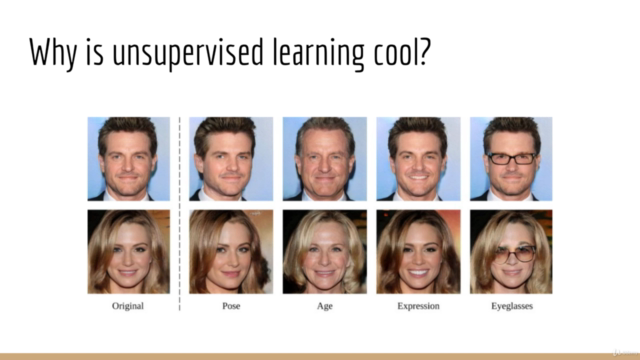Deep Learning: GANs and Variational Autoencoders

Why take this course?
🚀 Course Title: Deep Learning: GANs and Variational Autoencoders with Python, Theano, and Tensorflow
🎓 Headline: Master Generative Adversarial Networks and Variational Autoencoders – The Backbone of AI Innovations!
Unlock the Mysteries of AI with Deep Learning! 🧠✨
Welcome to a deep dive into the world of Generative Adversarial Networks (GANs) and Variational Autoencoders (VAEs), the very technologies that power groundbreaking AI applications like OpenAI DALL-E, Midjourney, and Stable Diffusion. In this comprehensive course, you'll explore the foundations of these pivotal innovations in deep learning and machine learning.
Understanding Unsupervised Learning 🕸️
Variational autoencoders and GANs represent two of the most captivating advancements in recent deep learning and machine learning developments. Yann LeCun, a luminary in the field, has even hailed adversarial training, the cornerstone of GANs, as one of the most important advancements!
The Dynamics of GANs 🤯
GAN stands for Generative Adversarial Network, where two neural networks engage in a competitive dance. One network generates data (the generator), while the other evaluates it (the discriminator). Together, they strive to outdo each other – the generator aiming to create realistic data, and the discriminator trying to distinguish between real and generated data.
Beyond Words: The Structure of Language, Art, and Music ✍️🎨🎶
Imagine a future where not only poetry but any form of text can be generated by machines. Envision an art piece born from the structure of music, or a new hit song composed by an AI. The potential applications of GANs and VAEs are as vast as human imagination itself.
Expanding Horizons: Beyond Traditional Deep Learning 🌟
This course isn't just about learning the structure of data; it's about producing outputs that mimic the original data, a feat that's both intriguing and practical. We'll also weave in concepts from Bayesian Machine Learning, Reinforcement Learning, and Game Theory to enrich your understanding and application of these technologies.
Hands-On Learning: Implement It to Understand It! 🖥️
My courses stand out because they emphasize implementing machine learning algorithms from scratch. You won't just learn to plug data into libraries – you'll gain a deep understanding of these algorithms by building them yourself. This hands-on approach ensures that you truly grasp the mechanics behind the scenes.
Suggested Prerequisites:
- Calculus
- Probability
- Object-oriented programming in Python
- Familiarity with Numpy for matrix and vector operations
- Knowledge of building feedforward and convolutional neural networks (preferably in Theano or TensorFlow)
Course Order Suggestion:
For the best learning experience, check out the lecture "Machine Learning and AI Prerequisite Roadmap" available in the FAQ of any of my courses, including the free Numpy course. This will guide you through the optimal order to take these courses for a solid foundation in machine learning and AI.
Why Choose This Course? 🏆
- In-depth explanations of every code line – ask questions anytime if something doesn't make sense!
- Realistic coding sessions – no unrealistic timelines or "typing" that can't be replicated in real life.
- No shy away from complex, university-level math – get the full picture with details often omitted by other courses.
Embark on a transformative journey through deep learning with this course as your guide. Dive into the world of GANs and VAEs and unlock the potential to create and understand some of the most intricate patterns in data. Your adventure into AI innovation begins now! 🚀🤖🌐
Course Gallery




Loading charts...
Comidoc Review
Our Verdict
Delve into this comprehensive deep learning course to expertly construct VAEs and GANs while exploring related foundational theories. Despite some convoluted explanations and undergraduate material, determined learners will benefit from useful debugging guidance and practical implementation lectures with PyTorch support. While not specifically targeted at beginners, ambitious students can still acquire valuable skills in this nuanced and engaging field.
What We Liked
- The course effectively builds Variational Autoencoders (VAEs) and Generative Adversarial Networks (GANs) in Python, using Theano and Tensorflow.
- It provides a clear explanation of the underlying foundations for cutting-edge technologies such as OpenAI ChatGPT, GPT-4, DALL-E, Midjourney, and Stable Diffusion.
- The instructor offers helpful suggestions and concepts when dealing with debugging issues, which enhances problem-solving skills.
- Several students find the practical implementation lectures to be particularly valuable, especially when utilizing PyTorch for GANs.
Potential Drawbacks
- Some explanations of key topics might not be as clear and concise as they could be, causing confusion among learners.
- There is an observable emphasis on re-purposed undergraduate material, which may lack the desired value-add in terms of clarity or industry application.
- The course's syllabus can create a misconception that it primarily focuses on GANs when, in reality, they only constitute about 25% of the content.
- Presentation style is considered plain and boring by some students.